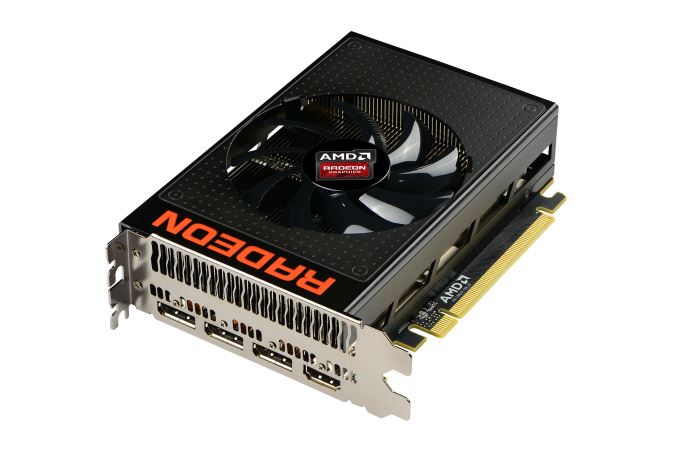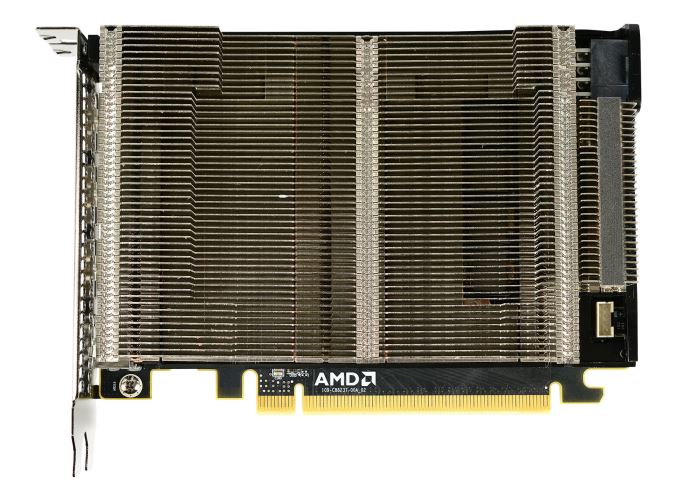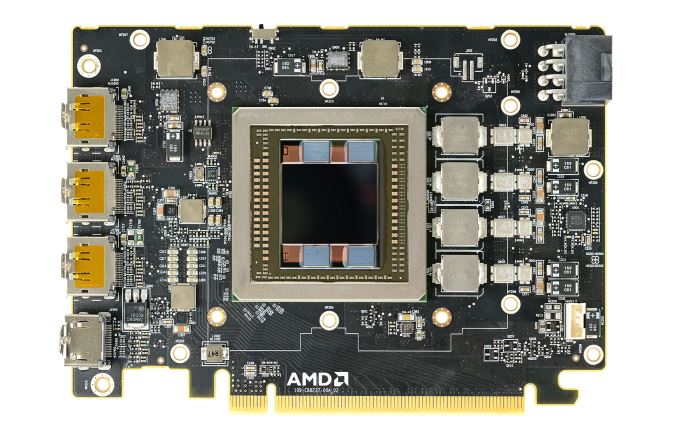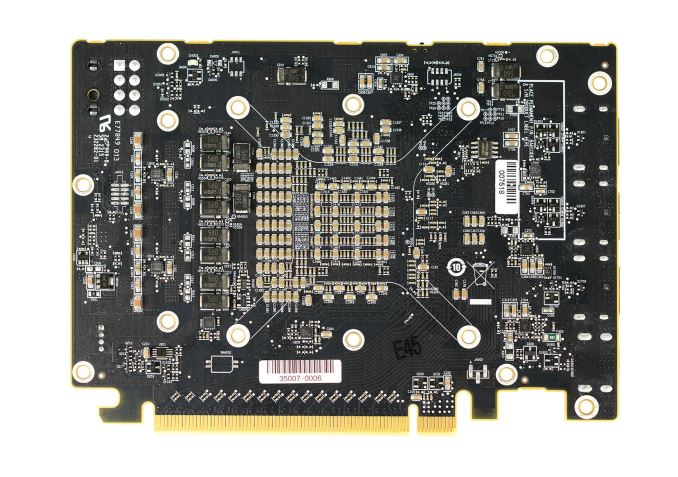The AMD Radeon R9 Nano Review: The Power of Size
by Ryan Smith on September 10, 2015 8:00 AM ESTMeet The Radeon R9 Nano
6 inch video cards are by no means a new thing in the GPU space, however these are traditionally lower-end products that need neither a large cooler nor an extensive power delivery system. As a result the R9 Nano is something of an interesting aberration, packing a lot more power and a lot more technology into half a foot of video card than what we normally see.
Starting as always from the top, the R9 Nano measures 6” long, which is actually a bit shorter than the full length the Mini-ITX standard allows. Responsibility for cooling the card falls to the R9 Nano’s new open air cooler, an aggressive design that has been specifically tailored to allow the card to effectively dissipate 175W of heat in such a small space.
The overall design of the R9 Nano’s cooler is best described as a combination open-air and half-blower hybrid. The design is technically open-air, employing a single axial fan to cool the card. However with only a single fan AMD has been able to align the heatsink fins horizontally and then place the fan in the center of the heatsink. The end result is that roughly half of the heat produced by the card is vented outside of the case, similar to a full blower, while the other half of the heat is vented back into the case. This reduces (though doesn’t eliminate) the amount of hot air being recycled by the card.
The heatsink itself is composed of aluminum and runs virtually the entire length of the card. This is technical a two-piece heatsink, with the primary heatsink composing the bulk of the card, while a much smaller secondary heatsink it found towards the far end of the card and mounted on top of a heatpipe.
Drilling down, we find that the primary heatsink is fed by a combination vapor chamber and heatpipe design. A copper vapor chamber serves to draw heat away from the Fiji GPU and HBM stacks, and then heatpipes are used to better distribute heat to the rest of the heatsink. The use of a vapor chamber in the R9 Nano makes a lot of sense given the fact that vapor chambers are traditionally the most efficient heatsink base type, however the R9 Nano is also unique in that we typically don’t see vapor chambers and heatpipes used together. Other designs such as the high-end GeForce series use a single large vapor chamber across the entire heatsink base, so among reference cards at least the R9 Nano stands alone in this respect. In this case given AMD’s design goals for size and noise, a vapor chamber will play a big part in helping the small card effectively and quietly dissipate 175W.
As for the physical PCB itself, as we can see AMD made it a relatively packed card in order to get the R9 Nano down to 6 inches. Compared to the R9 Fury X reference board, the biggest change here is that AMD has removed a fair bit of power circuitry to save space. By our count there are 4 VRM phases to feed the Fiji GPU, as opposed to the 6 found on R9 Fury X. Power delivery is handled by a single 8-pin PCIe power socket, which is becoming increasingly common, replacing the 2x 6-pin setup for 150W-225W cards.
Meanwhile to further shrink the overall PCB footprint, AMD has moved some of the remaining power delivery circuitry to the back of the card. The front of the card still contains the inductors and heat-sensitive MOSFETs, while a number of capacitors are on the rear of the card (and is why you won’t find a backplate).
Finally, for display I/O R9 Nano is unchanged from R9 Fury X. This means we’re looking at a DVI-free design, with 3x DisplayPort 1.2 and 1x HDMI 1.4 port all along a single row of the I/O bracket. Buyers looking to put together HTPCs will want to be especially mindful of the HDMI 1.4 port; while it's not necessarily a deal-breaker, it does mean that the R9 Nano can't fully drive 4Kp60 TVs, which are slowly but surely becoming more common.
Overall AMD is rather confident in their design for the R9 Nano. The heatsink is built to efficiently dissipate more heat than the 175W the card requires (despite the small size), and as a result we never see the R9 Nano thermally throttle under normal operation. The card’s thermal throttle point is 85C, and in our testing the card never passed 75C, exactly as AMD promised us. What ends up limiting the R9 Nano’s performance then is exactly as expected: the power throttling.
















284 Comments
View All Comments
gw74 - Friday, September 11, 2015 - link
Everything you say here is refuted by my previous comment.slickr - Saturday, September 12, 2015 - link
LOL. Either you are one of the biggest dumbasses out there or a shill yourself. To believe it was a "honest mistake" is like believing the earth is made out of cheese.They had at least 2 months to fix it and to rectify it, did they not read any of the hundred of reviews? They tried to cover it up and it was only when average CONSUMERS started noticing it and testing it that it was found out it had been a major fraud.
gw74 - Saturday, September 12, 2015 - link
insulting me, setting up a false dichotomy and a false analogy will not help you.They did not realise there had been an error during those 2 months, and none of the reviews mentioned it, because it does not noticeably affect performance except in certain SLI / 4K low framerate edge cases. It was only when until users starting reporting it in mid Jan. They had meetings between marketing and engineering then released a statement to PCPer on 24th Jan.
Oxford Guy - Tuesday, September 15, 2015 - link
Nvidia continued to lie to the public on its website by stating that the 970 has 224 GB/s, long after Anandtech's Correcting the Specs article was published — which made it clear enough that the card can't reach that number. Quit shilling.Alexvrb - Saturday, September 12, 2015 - link
Err, uh, the engineers only communicate in binary! The translator was sick that week! Locusts! It wasn't their fault!!Reality: "Well technically it has 4GB on there so we'll just... leave that detail out... they won't notice for months anyway. Then we'll apologize and a bunch of fanboys will defend us till the bitter end anyway."
If AMD had pulled a stunt like that they would have been raked through the coals till there were only ashes.
gw74 - Saturday, September 12, 2015 - link
no. that is not "reality". That is speculation.bigboxes - Thursday, September 10, 2015 - link
Utter nonsense. Nvidia knew damn well that they had a technical and marketing issue and lied through their teeth. Misleading reviewers, customers and the general tech community. It eventually came out and they went into full damage control. And before you say it, I bought an MSI GTX 970 Gaming 4G card after all this went down. I'm happy with this card, but it is what it is.gw74 - Friday, September 11, 2015 - link
you forgot to include evidence of them lying, or a reason for why they would lie.Oxford Guy - Friday, September 11, 2015 - link
It's called reality, dude.gw74 - Friday, September 11, 2015 - link
meaningless